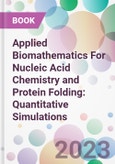The author presents research on methods to understand aspects of the molecular dynamics of nucleic acids, DNA melting, evolutionary genetics, protein folding of Crambin and DNA vitrification. The book consists of five chapters and an appendix on the theoretical investigation on 10-12 potential of Hydrogen-Hydrogen covalent bond. Some of the previous research published in İnternational Journal of Modern Physics C and Modern Physics Letters B is extended for additional insight.
Readers will find simple computer algorithms for hard mathematical physics problems such as mesoscopic, fractals, percolation, Metropolis algorithm and Langevin dynamics - many of which are also crucial to understanding experimental results of computer-aided drug discovery and cryopreservation. The author has taken care to explain calculations in a clear manner. All simulations have been conducted using Fortran (f77).
Readership
Advanced researchers and data scientists in the field of molecular dynamics, bioinformatics and systems biologyTable of Contents
- Contents
- Foreword
- Preface
- Acknowledgements
- Introduction
- Methods
- Results and Discussion
- Conclusion
- Disclosure
- References
- Introduction
- Calculation
- Results
- The Theory and Discussion
- Conclusion
- Disclosure
- References
- Dynamics for Folding of the Protein Crambin in a Viscous Environment
- Introduction
- Methods
- Theory
- The Monte Carlo Simulation
- Results and Discussion
- Assumptions
- Disclosure
- References
- Crambin
- Introduction
- The Model
- Calculation
- Conclusion
- References
- Introduction
- Theory
- Results and Discussion
- Conclusion
- References
- Hydrogen-Hydrogen Covalent Bond
- Introduction
- The Theory
- Calculations
- Results and Discussion
- Conclusion
- References
- Subject Index
Author
- Sencer Taneri








